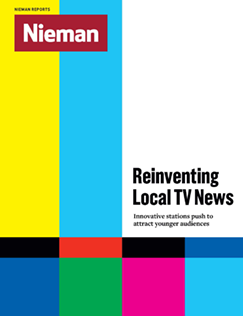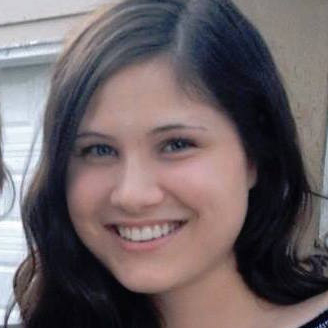
In WRAL-TV's production control room, operators view the station’s augmented reality set for their coverage of the 2018 Winter Olympics. Raleigh, North Carolina-based WRAL’s new AR/VR studio is one of many efforts by local television news stations to innovate in order to attract younger, more diverse audiences
When the Rev. Billy Graham died in February, Raleigh-based WRAL-TV provided expansive coverage of the famed evangelist’s life and legacy. That was no surprise since, after all, the pastor was a North Carolina native, and—though his funeral was held in his hometown of Charlotte, more than 150 miles away—generations of Raleigh-area residents had watched Graham’s global crusades, which WRAL broadcast beginning in the 1970s, on their home television sets.
In addition to reporting the news of Graham’s death, the station produced a 30-minute special, “Remembering Billy Graham.” It aired the day of his funeral, which was livestreamed on the WRAL website, Facebook, and their mobile news app as well as broadcast live on television, pre-empting the noon newscast.
Those interested in even more coverage of Graham could have turned to WRAL’s over-the-top (OTT) apps, available for Roku, Amazon Fire, Apple TV, and Chromecast. Any apps or online services such as Netflix, YouTube, and Skype, which bypass distribution via a telecommunications provider qualify as OTT. Shelly Leslie, general manager of audience development at Capitol Broadcasting, says the station added 35 pieces of Graham-related content–including clips of the motorcade bringing the preacher’s body to the cemetery in Charlotte—to the OTT apps. “We blew out regular content on the ‘watch now’ section of our OTT apps,” says Leslie, who was previously WRAL’s creative director. “We’re constantly experimenting with different content there and seeing what people want to watch.”
WRAL, the flagship station of Capitol Broadcasting Co., which owns two other TV and several radio stations in North Carolina, was one of the first local television news stations in the country to develop an OTT app. Their Roku app, first rolled out in 2010, offers streaming access to tens of thousands of clips from the station’s archive. Viewers can access everything from live and archived newscasts to live streams of legislative hearings, school board meetings, and court trials. Sports fans can watch events that don’t make the evening broadcast. These are live streamed on the OTT apps, WRAL.com, or its niche sites—wralsportsfan.com and highschoolOT.com—covering professional, college, and high school sports. OTT users also have access to WRAL documentaries from the past two decades, restaurant reviews, and podcasts from Capital Broadcasting’s sports radio stations.
At a time when local TV news is often written off as formulaic, with sensationalism triumphing over substance, a host of stations is experimenting with new ways to attract audiences
Another area in which WRAL is innovating is augmented and virtual reality. Many local newsrooms have been experimenting with augmented reality in their newscasts for several years, but WRAL is taking this a step further, recently opening its own AR/VR studio, which, according to Leslie, is the only one of its kind between New York and Atlanta. The studio enables WRAL to create a virtual world that presenters can interact with, which anchors did during the station’s coverage of the Winter Olympics. During their nightly half-hour broadcasts throughout the games of “The Olympic Zone,” anchors appeared to be located on the snowy mountains of Pyeongchang, South Korea. Augmented reality was used to place life-sized graphics, such as featured athletes, within the virtual set.
“We’re also developing our AR/VR studio into a separate business as a resource to the gaming industry, agencies, and corporations that want to explore AR/VR without having to send their crew to Toronto or LA,” says Leslie. Those with experience and their own graphics can rent the studio itself, or they can hire WRAL’s in-house team to produce their concept.
Likewise, the station’s efforts with OTT apps are creating a new revenue stream, garnering funds from the branded and paid content and ads for their OTT content. “Our data indicates there is absolutely a new audience watching via streaming, and I fully expect that to explode over the next two years,” says Leslie. “While demographic data is still lacking in this platform, we’re seeing steady growth month-to-month. The biggest surprise has been live newscast viewing, particularly morning news, [on the apps].”
Leslie says that OTT is all about choice and putting viewers in control. “Traditional broadcasting is like a buffet—you turn on the TV and you get whatever we are serving at that time. To get other offerings you have to go to another buffet—turn the channel. Streaming is more like ordering from an infinite menu. We can populate one app with so many choices, and you can choose what you want when you want it.”
WRAL is not alone in fostering innovation in local TV news. At a time when local TV news is often written off as formulaic, with sensationalism triumphing over substance, advertising stagnant, and viewership declining, a host of stations is experimenting with new ways to attract audiences.
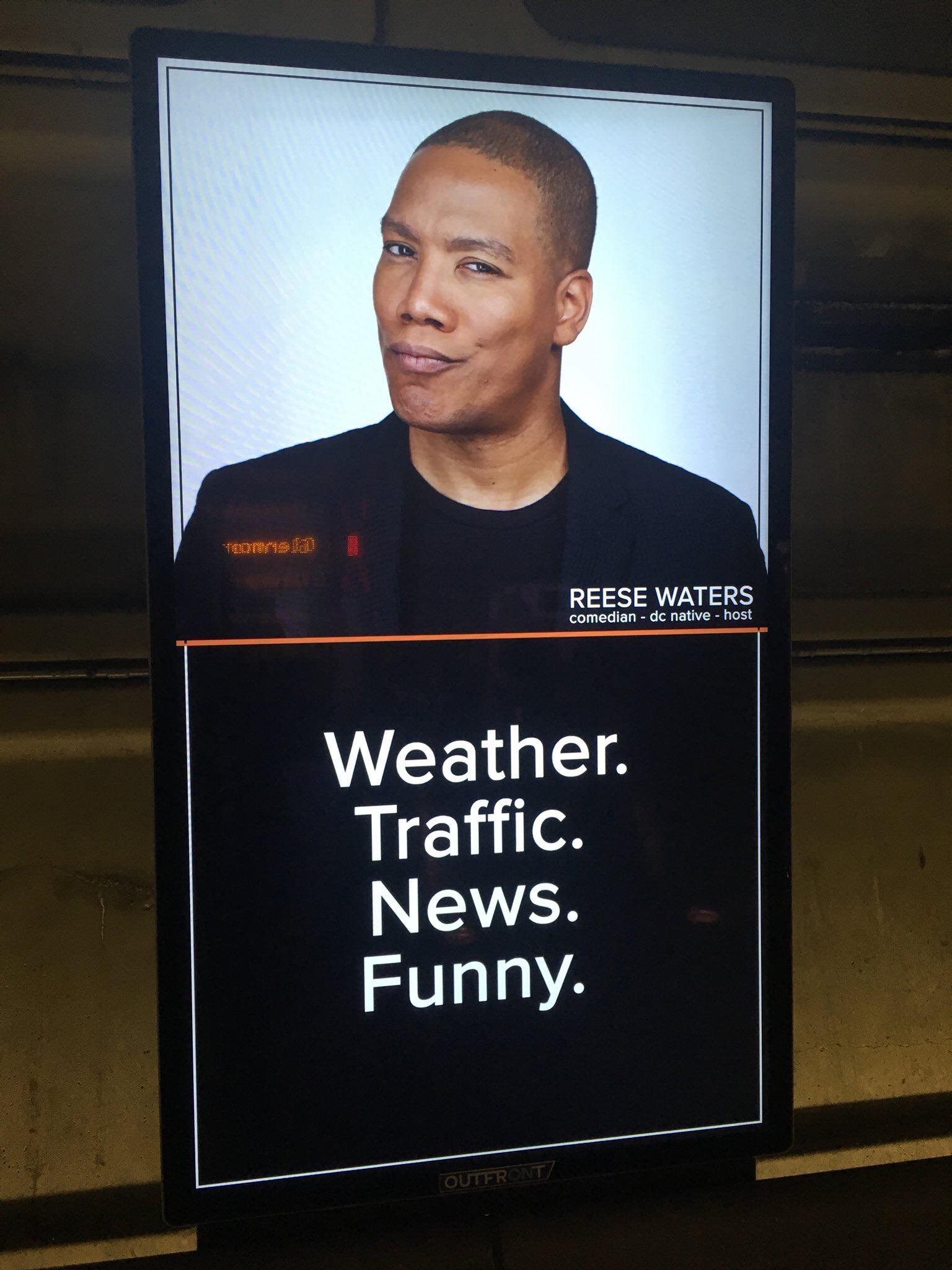
A promo for "Get Up DC," a new morning show—featuring comedian Reese Waters—at TEGNA-owned WUSA in D.C. Of the “big five” broadcasting companies, TEGNA stands out from its competitors in terms of innovation efforts
Local TV news is still what the majority of Americans turn to to keep informed. According to Pew’s most recent State of the News Media report, published in 2017, more people get their news from television than any other source, and, of those viewers, the majority get that news from their local TV station—and their websites. In smaller markets, especially, television stations’ websites—not those of newspapers—are often the dominant source of local news online, according to a recent report by the Knight Foundation. What’s more, unlike many print and digital-only publications, local TV news is still profitable. In 2016, local TV over-the-air advertising revenue totaled $20.6 billion, and nearly 85 percent of that was made by some 800 “news-producing stations,” according to Pew, with data from market researcher BIA/Kelsey.
Yet a shift is happening. Veteran news executive Mark Effron says the decline of local TV news over the past two decades could have terminal results if the industry fails to act now. “Because it is a slow drip and it’s not a big hole in the ground that TV stations are falling in, there is less of an urgency and a desire to innovate in a ruthless, all-out manner,” says Effron.
Now a journalism instructor at Montclair State University’s School of Communication and Media in New Jersey, Effron spent the bulk of his career in local and cable TV news as well as radio. “By all metrics, local television is still a very profitable medium, but it’s not as profitable as it was. Profit margins have shrunk over the last 30 years,” says Effron, as have ratings. “That doesn’t mean that they’re still not making a lot of money and reaching a lot of people, but they’re reaching less people and making less money.”
People of all demographics are turning away from television, and this is reflected in their news consumption. In 2016, Pew reported, 57 percent of adults said they often got their news from television, while 38 percent said they often got their news online. Just a year later, that gap had narrowed considerably: 50 percent television to 43 percent online.
Local TV still draws in the largest percentage of adults when comparing local, network, and cable TV news, but it has also seen the steepest drop-off in viewership in the last year. Pew reported that from 2016 to 2017 the share of adults regularly getting news from local TV fell from 46 to 37 percent. Only 18 percent of 18- to 29-year-olds often get their news from local TV, compared to 57 percent of those older than 64.
Education and income also play a role; nearly half of those who regularly watch local TV news have a high school education or less, about a quarter of viewers are college graduates, and those viewership shares are similar for those who make less than $30,000 a year versus those who make $75,000 or more.
Afraid of alienating older viewers, stations are wary of innovation that may draw new audiences in. “Even though I think a lot of television news organizations are really trying [to attract younger audiences], in some ways there’s a sense that the audience is always going to be an older, lower socioeconomic demographic,” says Effron. “I think it becomes a little bit of a self-fulfilling prophecy.”
The deterioration of the local news media poses dangers. Local stations are less likely today to offer robust coverage of city hall and state government. Reducing local news coverage may leave citizens less knowledgeable about issues of civic importance in their own communities.
Local TV still draws in the largest percentage of adults when comparing local, network, and cable TV news, but it has also seen the steepest drop-off in viewership in the last year
A number of initiatives are under way to strengthen the local news ecosystem, including an effort by Facebook to connect Facebook users with local news and the Knight-Lenfest Newsroom Initiative, a $4.8 million Knight Foundation-funded project to share best digital practices among metro newspapers. The second phase of the Knight-Lenfest effort focuses on local television. A collaboration with the Center for Innovation & Sustainability in Local Media at the University of North Carolina’s Chapel Hill School of Media and Journalism, the project works with two local television stations and other media outlets in North Carolina to share best practices and create a network of sustainable news outlets.
A $2.6 million Knight grant is aimed at advancing innovation and journalism excellence in local television newsrooms. The grant recipients are Arizona State University’s Walter Cronkite School of Journalism and Mass Communication and Arizona PBS, the public television station based at the school; the Emma Bowen Foundation, which will recruit college students of color for media internships at local television stations; the Radio Television Digital News Association (RTDNA), which will design a new annual training conference promoting the First Amendment and innovation; Investigative Reporters and Editors (IRE), which, to foster investigative journalism, will host data bootcamps, workshops, and trainings, and a new digital watchdog TV network; and the Carole Kneeland Project for Responsible Television Journalism, which will train newsroom leaders on topics ranging from community engagement and ethics to digital strategy.
Meanwhile, at Northeastern University’s School of Journalism in Boston, professors John Wihbey and Mike Beaudet are in the middle of a project called Reinventing Local TV News. They will partner with a handful of television stations around the country and, with help from graduate students, will experiment with some of the stations’ best journalism, telling the stories using non-traditional methods—perhaps adding animation or data visualizations. They will test the original and the remixed version in their broadcasting partners’ respective markets to see how audiences respond.
While TV stations are well-positioned to create high-quality, internet-native videos that might attract younger audiences who don’t watch television, too few are doing so. While 63 percent of stations say they are trying to attract younger demographics, according to a 2017 RTDNA survey, the majority defined those efforts as simply using social media. Only about 14 percent said they are looking at what they classified as “younger-oriented content on digital platforms.” Wihbey and Beaudet hope their project will show local TV stations how important it is to innovate and provide them with suggestions on how to do it.
Though local TV news stations have plenty of evidence from their print counterparts that the cost of inaction may be high, many have been slow to take action. Several months into the study, Wihbey and Beaudet say they’ve found “pockets” of innovation—such as Denver’s KUSA 9News. By and large, however, local TV news is stuck in its formulaic comfort zone, both in terms of which stories it tells and how it tells them. “Most television stations haven’t ventured far from the decades-old model of delivering a local newscast,” Beaudet says. “They often just repurpose their broadcast stories for digital and are more interested in racking up clicks than providing useful, engaging content online that might actually tempt a millennial to tune in to the traditional broadcast.”
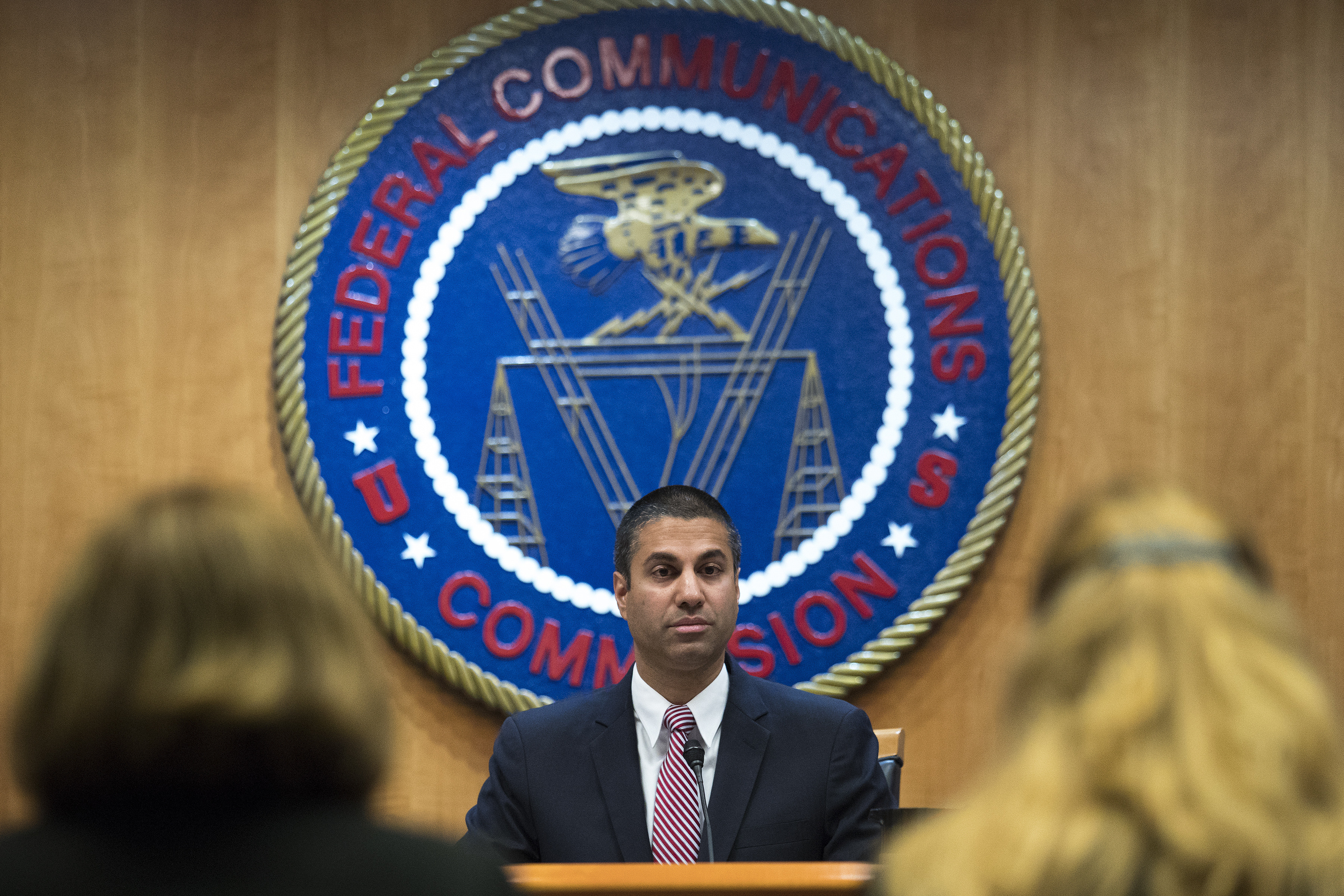
Ajit Pai, chairman of the FCC, delivers remarks at FCC headquarters in 2017. The FCC has recently rolled back rules limiting media ownership, paving the way for the acquisition of Tribune Media by Sinclair, which already is the nation’s largest broadcaster, with more than 190 stations
Beaudet believes that most stations are hesitant to innovate because they don’t want to risk turning viewers off. They’re also used to making the bulk of their money from ads and, increasingly over the last few years, the retransmission fees that cable and satellite providers pay broadcasters for the right to carry their signals. Compared to the $20.61 billion in TV ad revenue local TV stations made in 2016 (election ads boosted that figure), they drew in $7.93 billion in retransmission fees and a relatively puny $1 billion in digital ad revenue, Pew reported.
Further complicating the future, the local television landscape is in a state of change. FCC rules limiting media ownership have been rolled back, allowing companies to own more stations, thereby giving a few companies an outsized influence. By 2016, just five companies—Sinclair, Gray, Nexstar, TEGNA, and Tribune—owned 37 percent of all local stations, totaling nearly 450 stations among them. Less than 15 years ago, in 2004, those same five companies owned 179 full-power stations, according to a Pew Research Center analysis of SEC filings data. Their combined revenue has more than doubled, from $3.6 billion in 2004 to $8.3 billion in 2016.
As these companies’ holdings and revenue grow, many people with a stake in the local TV news industry are concerned about plans for their stations. That’s especially true for Sinclair, the nation’s largest broadcaster, which owns more than 190 stations across 89 markets and plans to buy all of Tribune’s stations for nearly $4 billion. This would give it access to an estimated 72 percent of American households. To increase its chances of winning Federal Communications Commission approval for the Tribune deal, Sinclair said it plans to sell stations in New York, Chicago, and elsewhere, then enter into agreements to operate the stations.
Not only are critics of the deal concerned about the dangers of media consolidation—particularly that the reach of independent and minority broadcasters would be diminished—but about Sinclair’s approach to news. Sinclair also has a history of issuing “must-run” news and commentary segments, scripts, and recurring features to its stations, limiting truly local fare. Recently, Sinclair required its anchors to read from a script saying they were “concerned about the troubling trend of irresponsible, one-sided news stories plaguing our country.” In early April, after Deadspin created a supercut of the promos that went viral, the company faced widespread pushback, with critics labeling the ads as pro-Trump propaganda. The company defended itself in an internal memo, obtained by CNNMoney, with senior vice president of news Scott Livingston writing, “The critics are now upset about our well-researched journalistic initiative focused on fair and objective reporting.” Livingston added, “For the record, the stories we are referencing in this campaign are the unsubstantiated ones (i.e. fake/false) like ‘Pope Endorses Trump’ which move quickly across social media and result in an ill-informed public. Some other false stories, like the false ‘Pizzagate’ story, can result in dangerous consequences.”
Not all stations owned by the five biggest broadcasters are driving to innovate; indeed, sometimes it’s smaller stations that, despite having a more limited reach and fewer resources, are leading the charge. For example, New Orleans’ Fox 8 WVUE-TV—a station that undertakes investigations with national impact—is owned by the midsize Raycom Media, which owns or operates 65 stations in 20 states. Lee Zurik was investigating rising drug prices for WVUE when a pharmacist mentioned that some customers’ health insurance copays were causing prescriptions to cost more than they would without any insurance at all—and the insurance companies were pocketing the difference.
Customers had no idea this was happening because pharmacies signed confidentiality agreements preventing them from telling anyone about the difference in price. The pharmacist who was Zurik’s source trusted that the highly acclaimed investigative reporter who also anchors two of WVUE’s newscasts would keep the pharmacist’s identity confidential. Zurik’s source provided documents proving what he was saying and talked about the price inflation on-camera—albeit with his voice disguised and face obscured. Zurik confirmed the information with other pharmacists.
By 2016, just five companies—Sinclair, Gray, Nexstar, TEGNA, and Tribune—owned 37 percent of all local stations, totaling nearly 450 stations among them
Zurik’s story, “Copay or You-Pay? Prescription Drug Clawbacks Draw Fire,” aired in May 2016 as part of his “Medical Waste” series. The reaction was immediate and widespread. People were outraged to find out that their insurance might be causing them to spend even more money on the drugs they needed. Outlets such as Bloomberg, CNN, and the Los Angeles Times subsequently did their own versions of Zurik’s story. So far, class action lawsuits have been filed against UnitedHealthcare, Cigna, and Humana as well as pharmacies CVS and Walgreens. Some states, including Zurik’s home state of Louisiana, are considering legislation outlawing the “gag clauses” that his report uncovered. The practice was a national issue, but it took a local TV news investigation to uncover it.
Chris Finch, Fox 8’s digital content director, says the station promotes Zurik’s stories on social media channels and typically hosts a live session on social platforms as a follow-up. “Facebook Live [videos] are the best way to tease stories on that platform,” says Finch. A typical investigative segment will get roughly 15,000 views, and having someone who provides instant feedback on live posts tends to increase the amount of time people spend watching the videos, says Finch. “The largest obstacle is coordinating someone who has the knowledge to answer questions in the feed while Lee answers questions live. It’s an orchestra.”
Another recent Zurik investigation, “Cracking the Code,” examined the costs of medical procedures. The series was a partnership between Fox 8 WVUE, NOLA.com/The Times-Picayune, and ClearHealthCosts, a New York-based journalism startup that aims to bring transparency to the healthcare marketplace. The project included, on Fox 8’s website, a Health Price Check Tool which allowed users to look up prices of various medical procedures—and compare costs (both with insurance and out-of-pocket) at different locations and providers.
To help bolster the tool as well as collect information that could be used for reports in the series, the news providers asked audiences to anonymously upload their own medical bills. Health Price Check was easy to access from the mobile app—a smart move considering about two-thirds of Fox 8’s digital audience comes from mobile devices, thanks in part to push alerts from Fox 8’s mobile app as well as Facebook, Finch says.
“Without question, mobile is probably the highest priority for news stations,” says Finch, and Fox 8 aims to give people a television experience on their mobile devices. Stories like Zurik’s are tailored to provide the best experience for audiences regardless of which platform they’re using. Desktop viewers may see more graphics and mobile users will get more clickables within the story to help keep the audience on the device longer, says Finch.
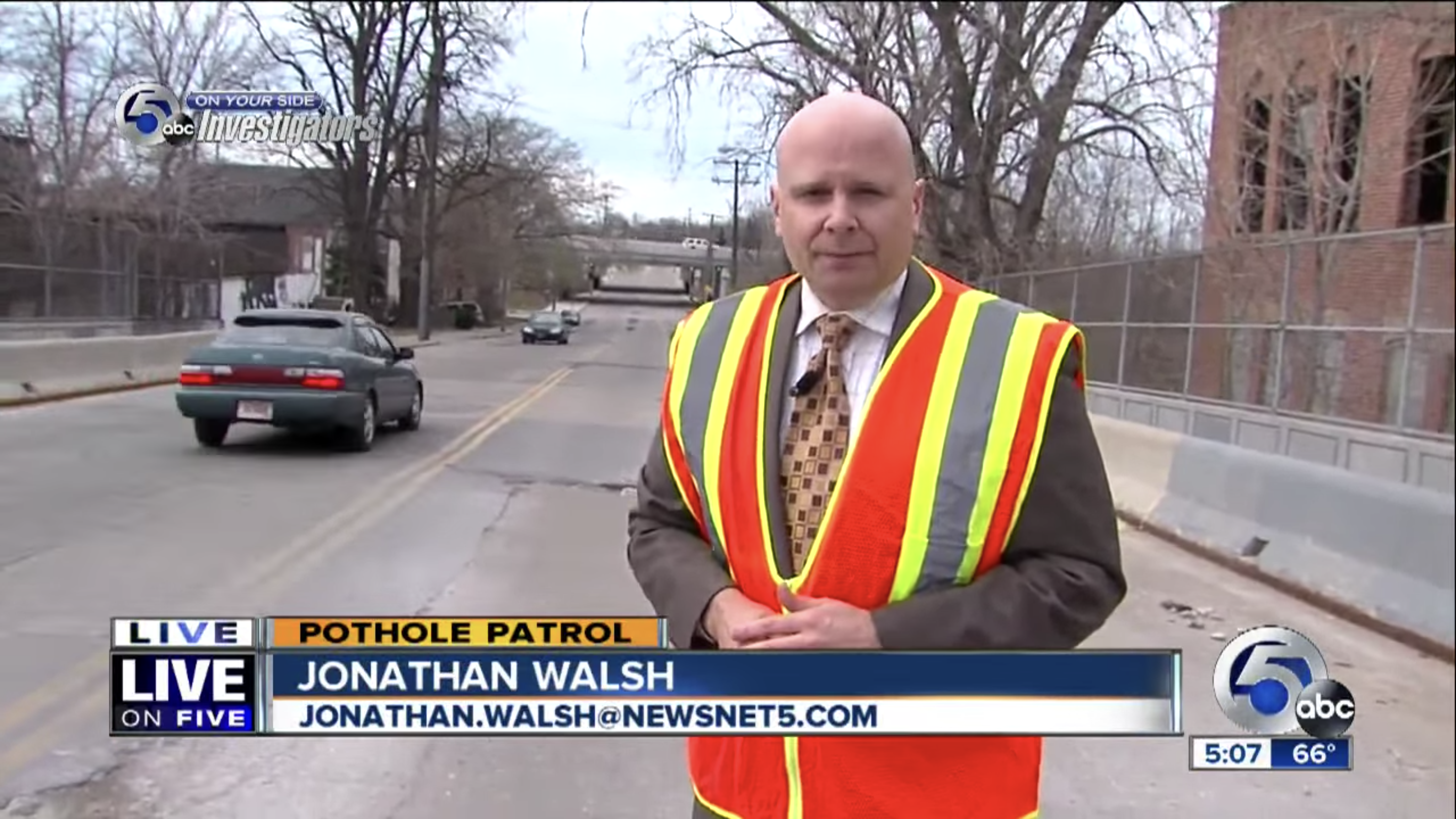
WEWS News 5’s “Broken Roads, Broken Systems” investigation, which grew out of their popular “Pothole Patrol” reports on Cleveland’s road conditions, demonstrated the importance of local TV news in holding institutions accountable and how a local station can use digital tools to enlist viewers’ help in investigating and telling the story
Like many cities in America, Cleveland’s streets are plagued by potholes, something that WEWS News 5, one of the stations owned by E.W. Scripps, reported on several times over the years in its popular “Pothole Patrol” segments. When investigative reporters Jonathan Walsh, Samah Assad, and Faith Boone dug into why the roads were so bad, they uncovered problems with the city’s method for evaluating and fixing streets. Their report, “Broken Roads, Broken System,” demonstrated the importance of local TV news in holding institutions accountable and how a local station can use digital tools, including interactive maps and a feedback form, to enlist viewers’ help in investigating and telling the story. “If you give the viewers the opportunity to interact with a story, they get to see and truly understand why the story is important and how it impacts them,” Assad says.
The city said it used a 2009 database of letter grades assigned to every street and a “worst first” policy to guide repaving decisions. It took Assad several months to get her hands on that database. Assad and Courtney Danser, then News 5’s executive producer of digital, created an interactive Google map that viewers could use to see what grade their streets had received. Another map showed what streets had been repaved between 2009 and 2015. On a feedback form, viewers could grade their street and then see if it lined up with the city’s grade for it. Viewers were also invited to send in photos.
This feedback from viewers was crucial to the reporting itself, revealing inconsistencies between the database and actual road conditions. Assad and the digital team discovered that some of the 16,000 streets listed in the report were either misnamed or nonexistent. Other streets were missing from the report; entire neighborhoods were skipped. Many of the worst streets—which should have been prioritized for repaving—were neglected for years and even decades. Meanwhile, streets with good grades were repaved.
Curious, they looked at the condition of streets that City Council members lived on. Sure enough, many City Council members’ streets had recently been repaved despite already being in good shape. They also found that City Council members had a say in which streets in their wards should be repaved—which meant that the city wasn’t relying solely on the “worst first” method. Besides, national experts on camera called the “worst first” ineffective.
Walsh highlighted other problems as well. On a street with a perfect rating from the city, Walsh lay down in a pothole so large and deep that his entire body fit in it.
News 5 has done several follow-up segments, some of which were inspired by viewers’ feedback and viewers are still weighing in via the feedback form. The “Broken Roads” series won a regional Emmy for continuing coverage as well as a regional Murrow award for excellence in innovation. In response, Cleveland announced it would work on shifting from a “worst first” to “fix-it-first” philosophy over the course of the next few years, and that it would be increasing funds for resurfacing projects, recommending spending between $12 and $18 million a year, compared to just $4.4 million spent in 2014, $7.5 million in 2015, and $10 million in 2016.
Afraid of alienating older viewers, stations are wary of innovation that may draw new audiences in
Innovation is paying off for WEWS News 5. Danser says the station has seen a steady increase in downloads of their mobile app, and its Facebook audience grew from about 272,000 in January 2017 to 364,427 in March 2018. The station continues to produce stories with digital-only components, including “Cleveland Abandoned,” which investigates the proliferation of dangerous abandoned properties, despite the mayor’s promises to tear them down. Like “Broken Roads,” it asks viewers to contribute to the reporting. “They tell us their stories and we investigate,” says Danser, who is now digital executive producer at ABC11 News in Raleigh-Durham, North Carolina. “We have a responsibility to not only tell, but also to listen. And that’s something these digital projects are helping us do more of.”
Of the “big five” broadcasting companies, TEGNA—which owns 47 stations and says it reaches 50 million adults on television and 35 million adults on digital every month—stands out from its competitors in terms of innovation efforts. The company holds innovation summits, bringing together journalists from its newsrooms across the country to brainstorm what broadcast news should be in the digital age. In Washington, D.C., it hired comedian Reese Waters to co-anchor WUSA’s new morning news broadcast “Get Up DC.” The show, which premiered in January, combines humor and trending stories with local news, weather, and traffic, and includes new segments such as “The Most DC Thing” and person-on-the-street trivia and other contests with passersby.
Another TEGNA station, Denver’s KUSA 9News, also is pushing boundaries. In August 2016, it launched “Next with Kyle Clark,” a personality-driven reinvention of the 6 p.m. news broadcast. Instead of weather and traffic reports mixed in with fluff pieces and crime stories, the 30-minute broadcast, hosted by popular anchor Clark, combines news and views for unique perspectives on what’s happening in Colorado.
Clark’s commentary is irreverent and honest. Case in point: reporting on a large rock in a local Target parking lot that cars regularly got stuck on top of. Tipped off by a Denver thread on Reddit devoted to the boulder and its “victims,” “Next” staked out the parking lot for Facebook Live viewers; a few minutes into the livestream, a red SUV was high-centered on the rock. “Next” made light of the situation that frustrated drivers and amused onlookers and tallied the cost to drivers whose cars were damaged. Ultimately, the station’s reporting led to removal of the rock—referred to as “one of [Next’s] dearest contributors.”

Kyle Clark (face-down) is the host of “Next with Kyle Clark,” a personality-driven reinvention of the 6 p.m. news broadcast on Denver’s KUSA 9News
So far, “Next” has been a mixed bag; ratings are slightly lower than its predecessor, but it is still in first place (9News has led the market for years) for its time slot. The best news: 70 percent of “Next’s” audience is new to the 6 p.m. broadcast, according to the station’s internal numbers. And Clark, who still co-anchors 9News’s traditional 9 and 10 p.m. broadcasts, has a knack for commentary that goes viral. A rant against viewer-submitted snow-covered patio furniture photos (“Why is it that every time it snows we whip out photos of our patio sets like we’re showing off baby photos of our kids?”) was covered by BuzzFeed, Huffington Post, and featured on the “Today” show. Another rant about a pet owner who left his dog in a hot car has been viewed 1.5 million times on Clark’s Facebook page.
9News also brought fresh thinking to “Blame” by investigative reporter Kevin Vaughan. “One of the mantras we have in this company,” he says, “is to be innovative, try new things, do something you’ve never done before and see how people react to it.” “Blame” examined the 2001 death of Jill Wells, who was shot in the head while she, her 6-year-old son Tanner, and her husband Mike were target shooting in their yard. Mike told police that Tanner accidentally shot Wells, and, after a brief investigation without an autopsy, the county coroner agreed. The story was told in a podcast, in print, online, and on TV.
Vaughan, who had first looked into the fatality in 2011 when he worked for The Denver Post, decided to revisit the case now that Tanner was an adult and his family was willing to participate. The Wells family lives near Colorado Springs, which is beyond the reach of 9News, so Vaughan’s 14,000-word story was simultaneously published in The Gazette in Colorado Springs and on 9News’ website. Vaughan referenced the police and coroner’s reports, Wells’ life insurance policy application, and her husband’s request for the payout, which was made the day after she died. Vaughan says, “I conceived this partnership with the idea that it would present the narrative version of the story in a community where there was great interest—and that that, in turn, would drive readers and viewers to our website and our airwaves.”
He knew from the start that his investigation might lack a definitive conclusion; Wells’ husband died in 2008 shortly after police re-opened an investigation into her death. Tanner did not want to be interviewed for the story, but wrote a statement insisting that he was the one who shot his mother. Vaughan countered this with a psychologist who said children’s memories tend to be unreliable, as well as a theory that Mike may have shot his wife while standing behind Tanner, who heard a gunshot, saw his mother fall, and assumed that he was the one who fired the rifle.
In May, 9News reported that the manner of death on Wells’ certificate was changed from “accident” to “could not be determined.”
The case illustrated the flaws of Colorado’s coroner system, which allows people with no law enforcement or medical experience to decide which deaths merit an autopsy.
For TV, the story was told in three segments, which were later stitched together for a half-hour special. The podcast was modeled on the popular true-crime “Serial.” On the website, the story was accompanied by case documents and a timeline with relevant photographs and audio clips, including the 911 call after the shooting.
Though local TV news stations have plenty of evidence from their print counterparts that the cost of inaction may be high, many have been slow to take action
Allison Sylte, a web producer for 9News, says the documents got the most views. Some features that worked on the desktop version of the site didn’t work for mobile readers. As the majority of 9News’ digital viewers came from mobile devices, Sylte says, it will be crucial that future enterprise stories do a better job with the mobile experience.
In an unorthodox move, the podcast went live four months before the TV and online stories. The 14-part “Blame” podcast, put together by 9News’ longtime investigative photojournalist and producer Anna Hewson, attracted more than 100,000 listeners—enough to prove that a podcast has potential to bring in revenue. Average engagement time on 9News’ website was high, exceeding 10 minutes; users usually spend less than a minute on stories. The story garnered about 500,000 views.
The innovation efforts of 9News, just like those of WRAL, Fox 8 WVUE, and WEWS News 5, are proof of how the local TV news landscape is, however slowly, shifting. “We have to really know our viewers and what matters to them. We have to listen,” says Capitol Broadcasting’s audience development manager Leslie. “Now more than ever, I think the audience is craving content that really matters to them and their daily lives, but they don’t want us deciding what that is for them. How do we give them choice? You have to get your audience engaged first.”
The story has been updated to correct the year that Colorado journalist Kevin Vaughan first looked into the killing of Jill Wells. It was 2011, not 2001 when the death occurred.

